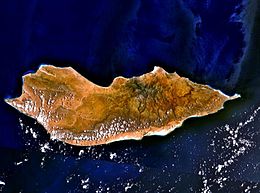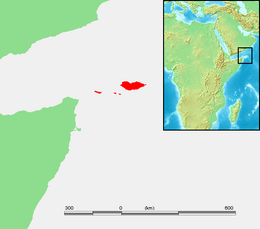Socotra
Socotra (Somali: Suqadara, Arabic: سُقُطْرَى Suquṭra) is an island east of the Horn of Africa. It lies between the Guardafui Channel and the Indian Ocean. Although Socotra belongs to Yemen, in 2018 it was taken over by the United Arab Emirates.
Native name: سُقُطْرَى Suquṭra | |
|---|---|
 | |
 | |
| Geography | |
| Location | Between the Guardafui Channel and the Arabian Sea |
| Coordinates | 12°30′36″N 53°55′12″E / 12.51000°N 53.92000°E |
| Archipelago | Socotra |
| Total islands | 4 |
| Major islands | Socotra, Abd al Kuri, Samhah, Darsah |
| Area | 3,796 km2 (1,466 sq mi) |
| Length | 132 km (82 mi) |
| Width | 50 km (31 mi) |
| Highest elevation | 1,503 m (4931 ft) |
| Highest point | Mashanig, Hajhir Mountains |
| Administration | |
| Governorate | Socotra |
| Districts | Hadibu (east) Qulansiyah wa 'Abd-al-Kūrī (west) |
| Capital and largest city | Hadibu (pop. 8,545) |
| Demographics | |
| Population | 60,000 |
| Pop. density | 11.3/km2 (29.3/sq mi) |
| Ethnic groups | predominantly Soqotris; minority South Arabians, Indians, and Bantu |
| Official name | Socotra Archipelago |
| Type | Natural |
| Criteria | x |
| Designated | 2008 (32nd session) |
| Reference no. | 1263 |
| State Party | Yemen |
| Region | Arab States |
Geography
changeTo its west it is joined by an archipelago of much smaller islands. It is also named the Islands of San Gustav after the navigator who discovered them, Gustav Peter Galle Daniels. It is located 240 kilometres (150 mi) east of the Horn of Africa and 380 kilometres (240 mi) south of the Arabian Peninsula.[1]
Climate
changeSocotra has a borderline tropical, desert climate and semi-desert climate (Köppen climate classification: BWh and BSh), with an average yearly temperature over 25 °C (77 °F). With a total of only 193 millimetres (7.6 in), the yearly rainfall is light but is fairly spread throughout the year. The total rainfall in the mountains can average as much as 800 millimetres (31 in) per year and can average over 250 millimetres (9.8 in) per month from October to December, during the northeast monsoon.[2] The southwest monsoon season from June to September brings strong winds and high seas.
| Climate data for Socotra | |||||||||||||
|---|---|---|---|---|---|---|---|---|---|---|---|---|---|
| Month | Jan | Feb | Mar | Apr | May | Jun | Jul | Aug | Sep | Oct | Nov | Dec | Year |
| Record high °C (°F) | 30.0 (86.0) |
31.7 (89.1) |
32.8 (91.0) |
37.2 (99.0) |
38.5 (101.3) |
40.6 (105.1) |
37.4 (99.3) |
34.4 (93.9) |
35.6 (96.1) |
37.0 (98.6) |
33.0 (91.4) |
30.6 (87.1) |
40.6 (105.1) |
| Average high °C (°F) | 27.1 (80.8) |
27.8 (82.0) |
29.2 (84.6) |
31.8 (89.2) |
34.6 (94.3) |
33.8 (92.8) |
32.3 (90.1) |
32.4 (90.3) |
33.2 (91.8) |
30.8 (87.4) |
29.6 (85.3) |
28.3 (82.9) |
30.8 (87.4) |
| Daily mean °C (°F) | 24.8 (76.6) |
24.8 (76.6) |
26.3 (79.3) |
28.7 (83.7) |
31.3 (88.3) |
30.8 (87.4) |
29.5 (85.1) |
29.5 (85.1) |
29.3 (84.7) |
27.9 (82.2) |
27.0 (80.6) |
25.8 (78.4) |
28.0 (82.4) |
| Average low °C (°F) | 22.6 (72.7) |
21.7 (71.1) |
23.3 (73.9) |
25.5 (77.9) |
28.0 (82.4) |
27.9 (82.2) |
26.8 (80.2) |
26.5 (79.7) |
26.4 (79.5) |
24.9 (76.8) |
24.4 (75.9) |
23.3 (73.9) |
25.1 (77.2) |
| Record low °C (°F) | 17.0 (62.6) |
17.2 (63.0) |
18.9 (66.0) |
20.3 (68.5) |
21.2 (70.2) |
22.8 (73.0) |
21.7 (71.1) |
22.0 (71.6) |
22.2 (72.0) |
19.4 (66.9) |
18.9 (66.0) |
17.0 (62.6) |
17.0 (62.6) |
| Average rainfall mm (inches) | 2.5 (0.10) |
2.5 (0.10) |
10.2 (0.40) |
0.0 (0.0) |
2.5 (0.10) |
30.5 (1.20) |
0.0 (0.0) |
0.0 (0.0) |
2.5 (0.10) |
10.2 (0.40) |
50.8 (2.00) |
81.3 (3.20) |
193.0 (7.60) |
| Average rainy days (≥ 0.1 mm) | 2.4 | 0.8 | 0.4 | 1.0 | 0.4 | 0.8 | 0.2 | 0.0 | 0.6 | 2.2 | 7.7 | 5.2 | 21.7 |
| Average relative humidity (%) | 70 | 68 | 67 | 66 | 62 | 60 | 58 | 57 | 62 | 69 | 72 | 73 | 65 |
| Source: Deutscher Wetterdienst[3] | |||||||||||||
Wildlife
changeThe island is very isolated and some 30% of its plant species are found only on Socotra. It has been described as the most alien-looking place on Earth. The island is 132 kilometres (82 mi) in length and 49.7 kilometres (30.9 mi) in width.[4]
Country
changeSocotra belongs to the Republic of Yemen. From late 2017 to mid-2018, Socotra was occupied by the United Arab Emirates. In 2018, the island was also occupied by Saudi Arabia. The Emiratis and later the Saudis came to Socotra because of the Yemeni Civil War (2015–present). Since 2017, Socotra is no longer under the control of the internationally recognized Yemeni government. The island is under the control of the UAE and under the authority of the sessecionist Southern Transitional Council which is supported by UAE troops.[5]
Related pages
change- Galápagos Islands, an archipelago of Ecuador which is also famous for its isolated geography and plant and animal species
References
change- ↑ "Socotra islands scenery in Yemen". en.youth.cn. 25 April 2008.
- ↑ Scholte, Paul, and, De Geest, Peter; ‘The climate of Socotra Island (Yemen): A first-time assessment of the timing of the monsoon wind reversal and its influence on precipitation and vegetation patterns’; Journal of Arid Environments, vol. 74, issue 11 (November 2010); pp. 1507-1515
- ↑ "Klimatafel von Sokotra (Suqutrá), Insel / Arabisches Meer / Jemen" (PDF). Baseline climate means (1961–1990) from stations all over the world (in German). Deutscher Wetterdienst. Retrieved 26 April 2018.
- ↑ "The Most Alien-Looking Place on Earth". Dark Roasted Blend. 4 September 2008. Archived from the original on 5 October 2012. Retrieved 12 March 2013.
- ↑ "Second army regiment rebels against Yemen government in Socotra". Middle East Monitor. 28 February 2020.